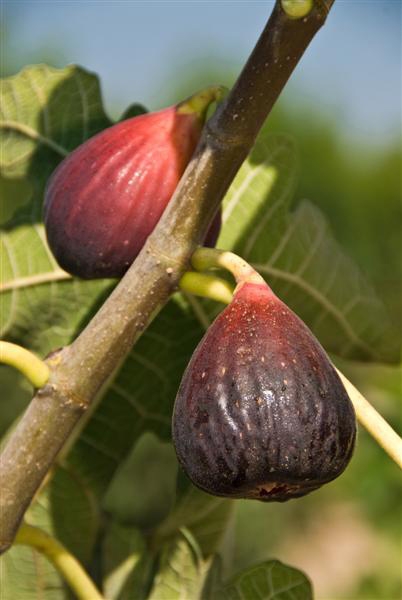Advice from the Help Desk of the
UC Master Gardener Program of Contra Costa County
Client's Request: I need some help with pruning, grafting, and transplanting young fruit trees. I'm especially interested in growing Brown Turkey Figs.
MGCC's Help Desk Response: Thank you for contacting the UC Master Gardener Program Help desk with your questions about pruning, grafting, and transplanting young fruit trees. Some of your questions were answered on the phone and others required some “digging”.
Before pruning any fruit tree, it is important to know its bearing habits, and ultimately what shape or size you would like the tree to be when it reaches maturity. You mentioned that you would like to know how and when to prune the Brown Turkey fig that you bought and planted in a pot last year. You also mentioned that you wanted to know how and when to graft a fig branch (or scion) from your son's tree onto yours.

Grafting a different fig cultivar onto your tree, involves taking scion wood from a healthy tree this winter, and preserving it in a bag with moist peat moss until spring when the grating should be done. Here is a link with detailed instructions about one grafting method you might try.
https://www.gardenguides.com/125489-graft-fig-tree.html
You might also consider getting hands on experience at the Golden Gate Chapter of the California Rare Fruit Growers Scion exchange on January 20th in Berkeley. Here you may take a grafting workshop, as well as finding hundreds of varieties of budwood for grafting and cuttings to root. Please see the following website for more information about the event, as well as its location. http://www.crfg.org/chapters/golden_gate/scionex.htm. (Editor's note: Many years ago, I attended the CRFG's Scion Exchange and brought home scions of 22 different types of figs. I planted them all directly 1 each in gallon containers. They all survived, much to my surprise, since I'm not fond of figs. Fig Newton cookies yes. They eventually all were donated to dia to a much better fate than my garden.)
You also mentioned that you have a two-foot-tall volunteer fig tree in your yard that you'd like to transplant. The best time to dig up and transplant a fig is now during its winter dormancy period. You will need to measure the trunk and calculate that for every inch of trunk diameter, you will need to allow for ten inches of root ball diameter when digging. So, if your tree is 1 inch in diameter you'll have to allow for an almost 1 foot diameter of root ball. You should also dig the root ball at least 1” beyond the canopy of the tree to minimize damage of any lateral roots.
Other important facts when transplanting your fig tree include: planting it in full sun, digging the new hole no deeper than the root ball, using existing soil when back filling the hole, and avoiding planting in areas that collect water, in order to mitigate the possibility of “wet feet”, which might make the tree more susceptible to root rot. Use the following link for a comprehensive guide to fruit tree planting and care. http://homeorchard.ucdavis.edu/8048.pdf
For more all-inclusive information on how to prune, including shaping, types of pruning cuts, and much more, see the following link. http://homeorchard.ucdavis.edu/8057.pdf
This is a lot of information to take in, but I hope that you are successful in your home gardening pursuits, especially for your fig trees.
Help Desk of the UC Master Gardener Program of Contra Costa County (JJM)
Note: The UC Master Gardeners Program of Contra Costa's Help Desk is available year-round to answer your gardening questions. Except for a few holidays, we're open every week, Monday through Thursday for walk-ins from 9:00 am to Noon at 75 Santa Barbara Road, 2d Floor, Pleasant Hill, CA 94523, although we will be moving sometime soon. We will notify you if/when that occurs. We can also be reached via telephone: (925)646-6586, email: ccmg@ucanr.edu, or on the web at http://ccmg.ucanr.edu/Ask_Us/ MGCC Blogs can be found at http://ccmg.ucanr.edu/HortCoCo/ You can also subscribe to the Blog (//ucanr.edu/blogs/CCMGBlog/)